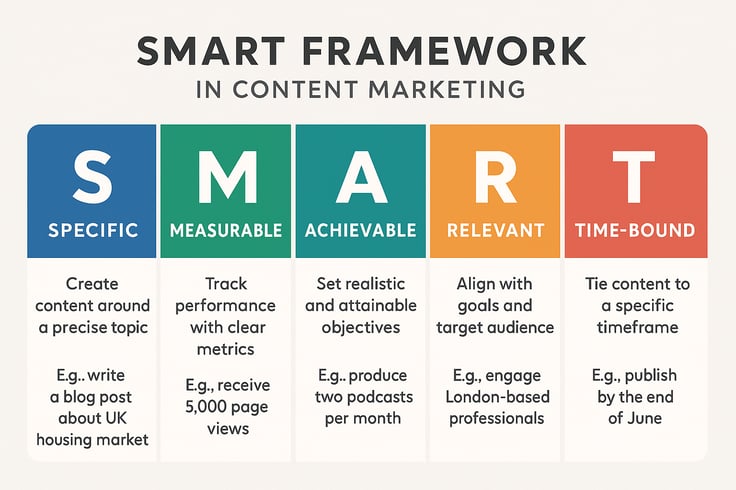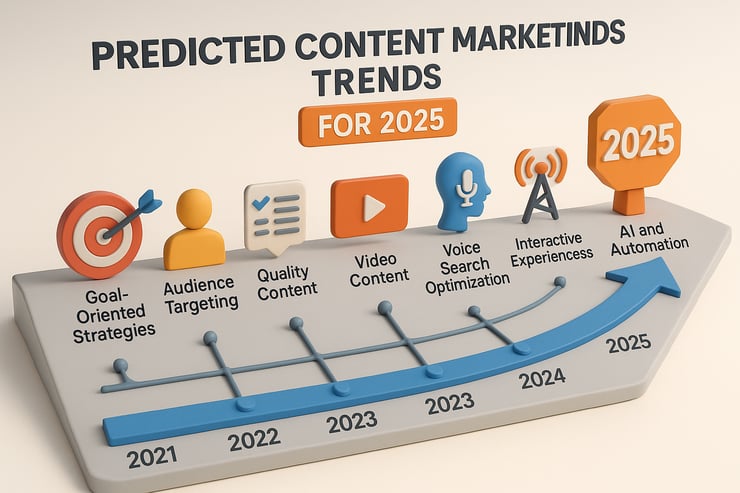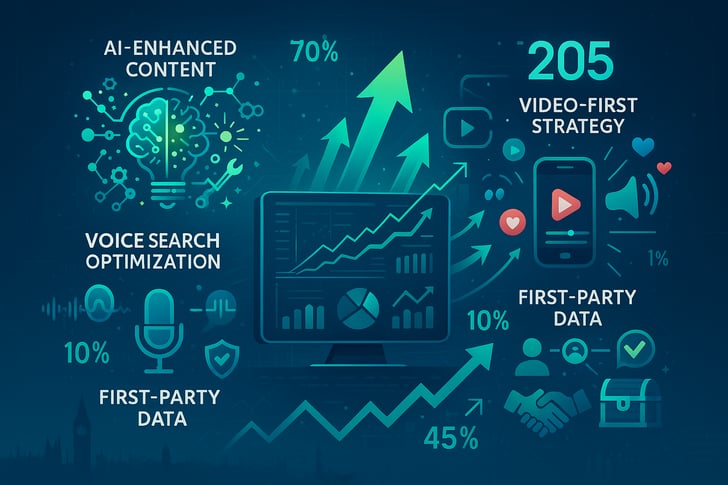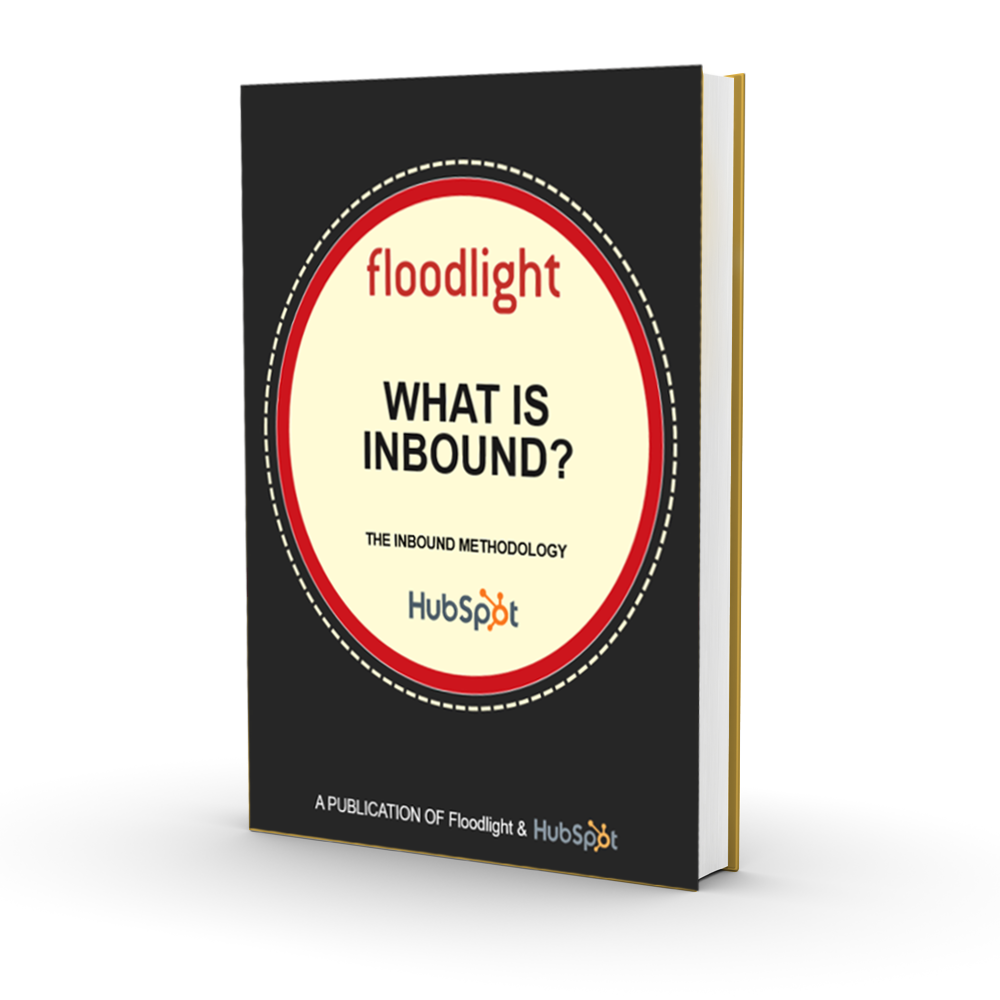Content Marketing Strategy: 8 Proven Tactics for 2025
Content marketing strategies are instrumental in elevating brand visibility and fostering engagement across diverse digital platforms. By utilising a blend of channels, tools, and data-driven insights, businesses can craft seamless, impactful campaigns that resonate with their audience. Here's a quick summary of the core principles to refine your approach:
- Set clear, measurable goals: Build your strategy on SMART objectives to track progress and align with business outcomes
- Leverage multiple channels effectively: Maximise the unique advantages of SEO, social media, email marketing, and paid advertising.
- Create detailed audience personas: Understand your customers' demographics, behaviours, and preferences to deliver targeted messaging.
- Produce high-quality, valuable content: Engage your audience with relevant, trustworthy resources that address their specific pain points.
- Implement strategic content distribution: Use multi-channel tactics to ensure your content reaches the right audience at the right moment.
- Maintain consistent messaging: Synchronise your branding across all digital channels to create a unified narrative.
- Measure performance continuously: Use KPIs to assess progress, identify gaps, and refine your approach.
- Adapt to emerging trends: Regularly update your strategy to incorporate new technologies and changing audience preferences.
Introduction: Why Your Business Needs a Content Marketing Strategy

In today's competitive digital landscape, simply having an online presence isn't enough to drive business growth. To genuinely stand out amongst the noise, UK businesses must develop a comprehensive content marketing strategy that not only amplifies brand visibility but also inspires meaningful connections with their target audience.
Recent research from the Content Marketing Institute reveals that 72% of marketers report that content marketing increases engagement, and 72% claim it has improved their lead generation. However, the key challenge many organisations face is effectively leveraging diverse channels while maintaining coherent messaging and a customer-centric focus.
Whether your goal is to attract new visitors, strengthen brand equity, or convert prospects into loyal customers, a well-constructed plan lays the foundation for achieving measurable success. Effective digital marketing depends on achieving synergy between tactics, platforms, and audience engagement, ensuring your online presence translates into tangible business outcomes.
This comprehensive guide equips you with the practical tools to design an integrated content marketing strategy that delivers results. From setting data-backed goals to leveraging the distinctive strengths of digital platforms, you'll learn how to elevate your marketing efforts and maximise their impact for your UK business.
1. Setting Clear and Measurable Goals for Content Marketing Success

Successful content marketing begins with a clear destination in mind. Well-defined, actionable goals not only provide a sense of direction but also empower teams to measure and refine their efforts effectively. Incorporating SMART (Specific, Measurable, Achievable, Relevant, and Time-bound) goals ensures a structured approach aligned with overarching business objectives.
How to Develop SMART Goals for Your Content Strategy
1. Specific: Define focused outcomes that replace vague ambitions. For example, rather than aiming to "improve email click-through rates," set a clear objective such as "achieve a 25% email click-through rate for our UK subscriber base within six months."
2. Measurable: Quantify goals to evaluate performance effectively. Analytical tools like Google Analytics and HubSpot allow you to track key metrics such as:
- Website traffic growth
- Engagement rates
- Conversion percentages
- Sales attributable to content
3. Achievable: Strive for success by setting goals that balance ambition with feasibility, based on your historical performance and available resources.
4. Relevant: Concentrate efforts on goals that align with core business priorities, such as:
- Increasing lead generation
- Enhancing brand positioning within your industry
- Improving customer retention rates
- Boosting revenue from specific product lines
5. Time-bound: Define precise deadlines to maintain momentum. For instance, aim to "grow Instagram followers by 20% within the next quarter" or "increase organic traffic by 35% in the next 12 months."
Case Study: SMART Success in British E-Commerce
A London-based sustainable fashion retailer aimed to increase quarterly revenue by 20% through content marketing. By introducing personalised retargeting ads featuring their sustainability credentials, creating location-specific content for UK audiences, and sending exclusive email offers to segmented customer groups, they achieved their goal in just eight weeks. Additionally, they saw a 15% boost in average basket value, demonstrating the power of SMART goals in driving actionable outcomes.
With clarity on your end goals established, it's time to explore how leveraging various digital platforms can turn those objectives into reality.
2. Leveraging the Strengths of Different Marketing Channels
![]()
A diverse range of digital channels enables businesses to craft tailored campaigns that cater to specific audience preferences. By integrating these channels into a cohesive strategy, companies can eliminate siloed inefficiencies and unlock exponential growth.
Maximising the Potential of Core Digital Channels
Search Engine Optimisation (SEO)
Establish long-lasting organic visibility by optimising your website for search engines. According to BrightEdge, 53% of all website traffic comes from organic search. Key tactics include:
- Conducting thorough keyword research focused on UK search trends
- Creating in-depth, engaging blog content that answers user questions
- Building authoritative backlinks from reputable UK websites and publications
- Optimising for voice search and mobile-first indexing
- Implementing proper technical SEO fundamentals
Social Media Platforms
Engaging channels like Instagram, LinkedIn, and TikTok empower businesses to foster meaningful connections. Each platform offers unique advantages:
- Instagram: Ideal for visual storytelling and product showcases (86% of UK adults aged 16-64 use Instagram)
- LinkedIn: Perfect for B2B content marketing and thought leadership (over 33 million UK users)
- TikTok: Excellent for reaching younger demographics with creative, authentic content
- X (formerly Twitter): Great for news, updates, and customer service (17.55 million UK users)
Email Marketing
A cost-effective tool for nurturing relationships with a remarkable ROI of £42 for every £1 spent, according to the UK DMA. Success factors include:
- Segmenting email lists by demographics, behaviour, and purchase history
- Personalising content based on subscriber interests and previous interactions
- Creating compelling subject lines that drive open rates
- Optimising CTAs for improved click-through performance
- Complying with UK GDPR for data protection
Paid Advertising (PPC)
Paid campaigns maximise visibility in a short timespan, offering precise targeting options across platforms like Google Ads or Meta Ads. Benefits include:
- Immediate visibility for time-sensitive promotions
- Granular targeting based on demographics, interests, and behaviours
- Performance tracking and optimisation in real-time
- Retargeting capabilities to re-engage website visitors
- A/B testing to refine messaging and creative elements
Integration in Practice: UK Fitness Brand Case Study
A Manchester-based fitness app enhanced its brand visibility by combining multiple channels in a unified campaign:
- They created SEO-optimised articles targeting standard UK fitness search terms
- Partnered with British fitness influencers for Instagram campaigns
- Deployed targeted PPC ads promoting a special membership offer to UK audiences
- Sent personalised email sequences based on user fitness preferences
This interconnected strategy boosted app downloads by 45% within the campaign period and increased membership sign-ups by 32%, demonstrating the power of channel integration.
3. Building Detailed Audience Personas for Targeted Messaging
![]()
Understanding who you're speaking to is pivotal for creating content that resonates. Buyer personas act as detailed profiles of your ideal customers, aggregating data-driven insights into actionable strategies. According to HubSpot, using personas makes websites 2-5 times more effective and easier to use by targeted users.
Essential Steps to Create Rich Buyer Personas:
1. Comprehensive Data Collection
Utilise multiple sources to build a complete picture:
- Website Analytics: Analyse demographics, geographic locations, and behavioural patterns
- CRM Data: Examine purchase history and engagement metrics
- Customer Surveys: Gather direct feedback on preferences and pain points
- Social Media Insights: Identify content that resonates with your audience
- Sales Team Input: Incorporate frontline insights about customer questions and objections
2. Identify Pain Points and Challenges
Conduct thorough research to recognise the specific problems your audience faces:
- In-depth interviews with existing customers
- Analysis of support tickets and customer service interactions
- Social listening to identify common complaints or questions
- Competitive analysis to understand unmet needs in the market
3. Segment for Precision
Adapt personas based on different factors:
- Funnel Stage: Create variations for awareness, consideration, and decision stages
- Purchase Behaviour: Distinguish between first-time buyers and loyal customers
- Value Segments: Identify high-value customers versus occasional purchasers
- Industry-Specific: For B2B, segment by industry, company size, or role
Example Persona: UK B2B Software Company
A British software company identified three key personas for their marketing automation platform:
1. Tech-Savvy Marketing Director Melanie:
- Demographics: 35-45, London-based, £80K+ salary
- Challenges: Needs to prove ROI on marketing spend, automate repetitive tasks
- Content preferences: Data-driven case studies, technical webinars, industry benchmarks
- Channels: LinkedIn, industry publications, email newsletters
2. Small Business Owner Simon:
- Demographics: 40-55, regional UK cities, 5-20 employees
- Challenges: Limited marketing budget, lacks specialised marketing staff
- Content preferences: How-to guides, template resources, pricing comparisons
- Channels: Facebook, small business forums, Google searches
By tailoring content specifically for these personas, the company achieved a 30% uplift in product adoption rate and reduced its sales cycle by 25%.
4. Creating High-Quality Content That Delivers Value

Amid the saturation of digital content, quality takes precedence over quantity. According to Demand Metric, content marketing costs 62% less than traditional marketing yet generates about 3 times as many leads. However, irrelevant or uninspiring material is quickly ignored, while engaging, actionable content keeps audiences coming back.
Key Guidelines for Developing Effective Content:
Focus on Solving Real Problems
Create content that directly addresses your audience's pain points:
- Research common questions using tools like Answer the Public
- Address specific challenges faced by UK audiences
- Provide actionable solutions that deliver immediate value
- Support claims with relevant data and expert insights
Personalise Your Approach
Tailor content to the specific needs of different audience segments:
- Adapt messaging based on persona characteristics
- Create region-specific content for different parts of the UK
- Develop industry-specific versions of key resources
- Customise by funnel stage (awareness, consideration, decision)
Diversify Content Formats
Incorporate multiple formats to engage different learning preferences:
- Blog Posts: In-depth articles and guides (1,500+ words perform best)
- Videos: Tutorials, explainers, and testimonials
- Infographics: Data visualisations and process breakdowns
- Podcasts: Interviews and discussions (37% of UK adults now listen to podcasts)
- Interactive Tools: Calculators, quizzes, and assessments
- Webinars: Live and on-demand educational sessions
- Case Studies: Detailed success stories with measurable results
Maintain Consistent Quality Standards
Establish clear guidelines to ensure all content meets high standards:
- Create a comprehensive style guide including UK English conventions
- Implement a robust editing and fact-checking process
- Ensure all statistics and sources are current and credible
- Incorporate SEO best practices without compromising readability
Case Study: Quality-Focused Content Strategy
A UK financial services provider shifted from publishing three short articles weekly to creating one comprehensive, data-rich guide every two weeks. The in-depth content addressed specific questions about personal finance for British consumers, incorporated interactive calculators, and featured expert videos.
Results:
- 87% increase in average time on page
- 65% improvement in organic search rankings
- 45% higher conversion rate from readers to leads
- 230% increase in social shares
This demonstrates how prioritising quality over quantity delivers superior outcomes for both audience engagement and business metrics.
5. Strategic Content Distribution and Channel Integration

Even outstanding content can't deliver results in isolation. According to the Content Marketing Institute, the most successful marketers spend 40% of their content marketing budget on distribution. Creating a strategic distribution plan ensures your valuable content reaches the right audience.
Effective Content Distribution Tactics:
Multi-Channel Distribution Strategy
Maximise reach by utilising multiple platforms:
- Owned Media: Your website, blog, email newsletters, and social profiles
- Earned Media: PR coverage, guest posts, and organic social sharing
- Paid Media: Sponsored content, social media advertising, and PPC
- Shared Media: Industry forums, communities, and partner distributions
Repurpose Content Across Formats
Extend the lifespan of your content by transforming it:
- Convert blog posts into infographics or slideshows
- Transform webinars into video clips and blog posts
- Use podcast content to create social media snippets
- Compile related blog posts into comprehensive guides
Timing and Frequency Optimisation
Deliver content when your audience is most receptive:
- Analyse engagement data to identify optimal posting times for UK audiences
- Develop a consistent publishing schedule to build audience expectations
- Consider seasonal factors relevant to British consumers or businesses
- Plan content around industry events and national holidays
Implementing Integrated Messaging Across Channels
Consistency across platforms reinforces your brand message and builds trust. Research shows that consistent presentation of a brand increases revenue by an average of 33%.
Techniques for Campaign Integration:
1. Unified Visual Identity:
- Maintain consistent design elements across all channels
- Use the same colour schemes, typography, and imagery
- Adapt visual assets appropriately for each platform's specifications
2. Cohesive Messaging Framework:
- Develop core messaging pillars that inform all content
- Create a centralised content calendar for campaign alignment
- Ensure consistent terminology and voice across all materials
3. Cross-Channel Promotion:
- Promote email content on social media
- Drive social followers to download gated content
- Include blog highlights in email newsletters
- Add social sharing options to all content
Case Study: Integrated Campaign Success
A Leeds-based property technology company launched an integrated campaign around "The Future of UK Property Management":
- Published a comprehensive research report as gated content
- Created a series of blog posts highlighting key findings
- Developed an infographic summarising trends for social sharing
- Hosted a webinar featuring industry experts discussing the research
- Distributed key statistics via LinkedIn and X
- Sent targeted emails to different segments with personalised insights
This integrated approach generated 3.5x more leads than their previous siloed campaigns and resulted in a 28% increase in marketing-qualified leads for their sales team.
6. Measuring Performance and Continuous Optimisation

Effective content marketing requires ongoing measurement and refinement to ensure optimal results. According to a survey by the Content Marketing Institute, 75% of the most successful content marketers measure content performance. By tracking key metrics, you can identify what works, what doesn't, and where to focus your resources.
Essential Content Marketing Metrics:
Awareness and Reach Metrics
Measure how widely your content is being discovered:
- Website traffic growth (new vs. returning visitors)
- Social media reach and impressions
- Brand mention volume and sentiment
- Search engine ranking positions for target keywords
Engagement Metrics
Evaluate how audiences interact with your content:
- Average time on page
- Pages per session
- Social engagement rates (likes, shares, comments)
- Email open and click-through rates
- Video watch time and completion rates
Conversion Metrics
Track how content drives business results:
- Lead generation numbers
- Conversion rates at different funnel stages
- Cost per lead by content type
- Sales influenced by specific content pieces
- Customer acquisition cost
ROI Metrics
Measure the business impact of your content investment:
- Revenue attributed to content marketing
- Lifetime value of content-acquired customers
- Cost savings (e.g., reduced customer service inquiries)
- Content production cost vs. performance
Implementing a Data-Driven Optimisation Process:
1. Regular Performance Reviews:
- Conduct weekly tactical reviews of ongoing campaigns
- Perform monthly strategic assessments of overall performance
- Complete quarterly deep dives into trends and opportunities
2. A/B Testing Framework:
- Test headline variations to improve click-through rates
- Experiment with different content formats for the same topic
- Try various CTAs to optimise conversion rates
- Compare different distribution channels for efficiency
3. Content Audit Process:
- Analyse high-performing vs. underperforming content
- Identify content gaps based on audience needs
- Update or repurpose outdated but valuable content
- Prune or consolidate underperforming content
Case Study: Data-Driven Content Optimisation
A Glasgow-based SaaS company implemented a comprehensive measurement framework for their content marketing:
- They discovered through analytics that in-depth guides (2,000+ words) generated 3x more leads than shorter blog posts
- A/B testing revealed that case studies featuring UK companies outperformed generic ones by 47%
- Content audit identified that updating old blog posts with new statistics and examples improved their traffic by 35%
By following the data, they reallocated 60% of their content budget to creating comprehensive resources and updating existing content, resulting in a 52% increase in marketing-qualified leads while maintaining the same budget.
7. Adapting to Emerging Content Marketing Trends

The digital landscape evolves rapidly, and staying current with emerging trends is essential for maintaining a competitive advantage. According to research by Smart Insights, 45% of organisations don't have a clearly defined digital marketing strategy, creating an opportunity for forward-thinking businesses to gain market share.
Key Trends Reshaping Content Marketing in 2025:
AI-Enhanced Content Creation and Personalisation
Artificial intelligence is transforming how content is produced and delivered:
- AI tools help create first drafts and generate content ideas
- Machine learning enables hyper-personalised content experiences
- Predictive analytics identifies topics likely to resonate with audiences
- Natural language processing improves content optimisation
Implementation tip: Utilise AI to automate routine content tasks, allowing human creativity to focus on strategic thinking and emotional storytelling.
Video-First Content Strategies
Video continues to dominate engagement metrics across platforms:
- Short-form video (under 60 seconds) drives social engagement
- Live video builds authentic connections with audiences
- Interactive video increases participation and information retention
- Shoppable video streamlines the path to purchase
Implementation tip: Create a video content library that can be adapted for different platforms and purposes, ensuring efficient resource use.
Voice Search Optimisation
With smart speakers in 31% of UK households, voice search optimisation is increasingly important:
- Conversational keywords that match natural speech patterns
- Question-based content that directly answers common queries
- Featured snippet optimisation to secure position zero
- Local SEO focus for location-based voice searches
Implementation tip: Create dedicated FAQ content that directly answers questions your audience is likely to ask voice assistants.
First-Party Data Strategies
As third-party cookies phase out, first-party data becomes crucial:
- Value-exchange mechanisms to collect customer data ethically
- Content personalisation based on first-party behavioural signals
- Community building to foster direct relationships
- Interactive content that generates insights while providing value
Implementation tip: Develop premium content offerings that provide enough value for users to share their information willingly.
Framework for Trend Adaptation:
1. Regular Trend Monitoring:
- Subscribe to UK marketing publications and research reports
- Participate in industry webinars and conferences
- Monitor competitors' adoption of new approaches
- Test emerging platforms with limited investment
2. Balanced Innovation Approach:
- Allocate 70% of resources to proven tactics
- Invest 20% in optimising existing approaches
- Reserve 10% for experimenting with emerging trends
- Document learnings from all experiments, successful or not
3. Customer-Centric Evaluation:
- Assess new trends based on audience relevance, not just novelty
- Gather feedback from customers about new content approaches
- Monitor engagement metrics when implementing new formats
- Be willing to abandon trends that don't resonate with your audience
Case Study: Successful Trend Adaptation
A Birmingham-based retail brand recognised the growing importance of user-generated content and community building:
- They developed a branded hashtag campaign encouraging customers to share product experiences
- Created a customer community platform featuring exclusive content and early access to new products
- Implemented a content co-creation programme with their most engaged customers
- Launched a TikTok channel featuring authentic customer testimonials and usage tips
This community-focused approach resulted in a 78% increase in social engagement, 25% higher conversion rates from social traffic, and generated authentic content at a fraction of the cost of traditional production.
8. Conclusion: Building Your Content Marketing Roadmap
![]()
In today's competitive digital landscape, an effective content marketing strategy serves as the cornerstone of business success. With UK consumers exposed to thousands of brand messages daily, the organisations that cut through the noise are those with well-executed, audience-centric content strategies.
By implementing the principles outlined in this guide—setting clear goals, leveraging various channels, understanding your audience, creating valuable content, distributing strategically, measuring performance, and adapting to trends—your business can transform its marketing effectiveness and achieve sustainable growth.
Your Next Steps:
- Conduct a content audit to understand your current performance and identify gaps
- Develop or refine your audience personas with UK-specific insights
- Create a 90-day content plan with clear objectives and KPIs
- Implement a measurement framework to track progress and inform optimisation
- Schedule regular strategy reviews to adapt to changing market conditions
Remember that content marketing is a marathon, not a sprint. The most successful companies maintain consistent effort over time, continuously refining their approach based on performance data and emerging opportunities.
Those who embrace innovation, analyse performance metrics, and adapt to shifts in audience behaviours will not only survive but thrive in the ever-evolving world of content marketing. Now is the time to take action and transform your marketing efforts into measurable success stories.
Frequently Asked Questions About Content Marketing Strategy

How much should I budget for content marketing?
The Content Marketing Institute recommends allocating 25-30% of your total marketing budget to content marketing. UK businesses typically see the best results when they maintain consistent investment rather than pursuing sporadic campaigns. For startups and SMEs with limited resources, focus on creating a smaller volume of high-quality content rather than sacrificing quality for quantity.
How long does it take to see results from content marketing?
Content marketing is a long-term strategy that typically shows meaningful results in 3-6 months. Early indicators, such as increased traffic and engagement, may appear sooner, but lead generation and revenue impact typically require more time to materialise. This timeline can vary based on your industry, competition level, and the quality of your execution.
Should I create separate content strategies for different social media platforms?
Yes, each platform has unique audience expectations and content formats. While your overall messaging should remain consistent, you should adapt your approach for each channel. For example, LinkedIn content should be more professional and industry-focused, while Instagram content should emphasise visual storytelling. Create a core content strategy with platform-specific tactical plans.
How do I measure content marketing ROI?
Calculate content marketing ROI by tracking both costs and outcomes. On the cost side, include content creation, distribution, tools, and team time. For outcomes, track metrics like leads generated, sales influenced, and customer retention rates attributable to content. Use attribution models in Google Analytics and CRM systems to connect content engagement with business results.
What types of content work best for B2B versus B2C companies?
B2B companies typically see strong results from in-depth content like whitepapers, case studies, industry reports, and webinars that demonstrate expertise and address specific business challenges. B2C companies often find greater success with entertaining and emotionally engaging content, including user-generated material, short videos, and interactive experiences. However, both sectors benefit from educational content that solves customer problems.
How can I repurpose content effectively?
Start by creating "pillar" content pieces (like comprehensive guides or research reports) that can be broken down into multiple formats. For example, a webinar can be transformed into blog posts, social media clips, an email series, and an infographic. Adapt the tone, format, and depth based on the platform while maintaining consistent core messages. This approach maximises your return on content investment.
Is it better to create content in-house or outsource it?
The best approach often combines both strategies. Keep strategic planning and content that requires deep product knowledge in-house, while considering outsourcing specialized formats, high-volume needs, or technical topics to agencies or freelancers. Many UK businesses use a hybrid model where internal teams manage strategy and SME input while external resources help with production and specialised formats.
How often should I update my content marketing strategy?
Review your content strategy quarterly to assess performance and make tactical adjustments, with a more comprehensive review annually. However, remain flexible enough to respond to significant market changes, competitor moves, or new platform opportunities as they emerge. Regular data analysis should inform continuous optimisation rather than waiting for scheduled reviews.

